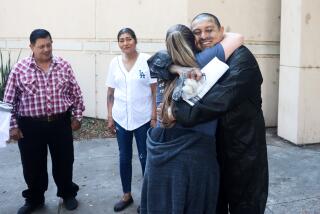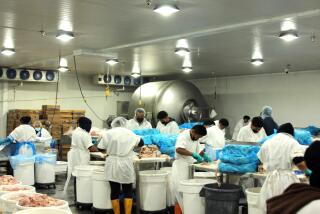When Labor Turns Deadly: Every 5 Days, a Child Is Killed on Job
PORT ARTHUR, Texas — Every five days in America, a child is killed on the job.
For 14-year-old Alexis Jaimes, that day was June 7, 1997.
The moment was 9:34 that Saturday morning on a construction site in this Gulf Coast town. As Alexis bent over to move hydraulic lines for the pile-driving crane he worked beneath, its 5,000-pound hammer broke loose and fell on him.
Frozen by the sight of the boy’s broken body, his back, legs and ribs crushed, a co-worker could only tell police, “It happened very quickly.”
Yes and no.
True, the coroner concluded, Alexis died instantly. But his death, like those of 70 other children the National Institute for Occupational Safety and Health says are killed each year at work, resulted from factors long in the making.
This year, Ricky Rash, 16, a roofer’s helper, fell six stories to his death in Florida. Arthur McEachern, 17, was buried at an excavation site in Massachusetts. Both died on jobs the law deems too dangerous for their age.
At least four in 10 children killed on the job are doing work prohibited by federal child labor laws, according to NIOSH. But when Samuel Stoltzfus, 12, was run over and killed by a wagon on his family’s Pennsylvania farm, he was working within the child labor laws.
A total of 200,000 children are injured on the job annually, and a third of the injuries are serious enough to require emergency room treatment, according to NIOSH.
Children are injured or killed because they are inexperienced in their work, or because employers don’t provide safety or skills training, don’t know child labor law or don’t check the ages of their youngest laborers.
Joshua Henderson, 15, was electrocuted while removing a shorted-out motor inside a Colorado car wash. His father, Mark Henderson, angrily repeats the warning of the motor manufacturer: “Call an electrician.” The car wash was cited for safety and child labor law violations.
Children are injured or killed because they are determined to prove themselves, to demonstrate independence.
Working alone at a Tennessee junkyard, a task banned by federal law, 16-year-old James Ford wanted to show he could winch up an old Buick by himself. “As soon as I heard the metal twist,” he says grimly now, “I knew what was happening.” The car’s fall left him paralyzed.
“What teenager doesn’t think they’re indestructible?” says his lawyer, Thomas Whiteside. “I think that’s why we still call them children.”
Children are injured or killed because parents, despite reservations, give in to kids’ pleading, then never suspect on-the-job danger until too late. Sometimes, as with accidents that kill and cripple children across the nation’s farm belt, tradition and the law’s exemption for work on family farms share the blame.
“It just didn’t have to happen,” says Carl Simon, an Iowa farmer whose son Corey, 6, died in a fall from the cab of a tractor driven--legally--by a 9-year-old. Simon blames a faulty door latch and a lack of supervision, not the driver’s youth.
“The boy was not too young to drive,” he said. “But put two of them alone, that’s when you’ve got to watch ‘em.”
U.S. Labor Department officials say policing child labor hazards is a priority, but they say their enforcement staff is small.
Darlene Adkins of the National Consumers League questions the department’s commitment. “If there were a toy that was harming 200,000 kids a year,” she says, “it’d be off the market.”
“We haven’t had good enforcement for years,” complains Jeffrey Newman of the National Child Labor Committee. “If government would take the role that the law requires of it, youth worker injuries and fatalities would be cut in half.”
*
Juan Jaimes repeatedly relives the day the pile driver cut his son in half. He stands in Alexis’ room, unchanged since the accident, and remembers once again.
“If I had said, ‘No, you can’t go to work,’ he’d have stayed at home,” the father whispers. “But only God knows.”
Alexis was eager for a job. “He was telling me, ‘I’m going to go to work with my dad,”’ recalls classmate Jose Lemus, who knew about the heavy construction work Juan Jaimes did. He remembers warning Alexis: “‘Man, that’s not good. You’re only 14 years old.’ He was like, ‘I know, but. . . .’ He just wanted to make some money.”
He wasn’t hired to do construction work, prohibited for someone his age. Instead, he was part of a landscaping crew planting marsh grasses.
But Alexis, friends said, always took on something extra. That day, he started helping under the pile driver as it pounded creosote-treated poles as big as tree trunks into the sandy ground.
*
America’s more than 4 million working children, legal and illegal, encounter many dangers. Of those treated in emergency rooms, 54% are injured working in retail jobs, 20% in service jobs, and 7% in agriculture, with the rest occurring in a variety of different industries, a recent study showed.
They are crushed by forklifts, burned while cooking or sliced by machetes they swing for hours as migrant field workers.
“You have to be going fast, cutting the trees, so that you can get good pay,” says Iliana Sifuentes, 16. Her thumb and finger were cut when her machete slipped as she trimmed branches on a Wisconsin Christmas tree farm last July.
Her severe cuts were bandaged without a doctor, and so, as is often the case, the injury was not recorded in government statistics. And, as is often the case, the dangerous work Iliana was doing was legal.
Blades were in the hands of many child workers observed by the Associated Press: a curved hook that a 10-year-old raisin harvester held in California; the clippers an 11-year-old used to cut ferns in Florida; a foot-long knife wielded by a 15-year-old tomato plant cutter in Tennessee; a power saw operated by a 16-year-old boy in Ohio.
Power-saw use is illegal for workers under 18, as are 16 other types of hazardous jobs, including mining, roofing, sawmill work, most vehicle driving, manufacturing of explosives, demolition, and working near radioactive materials.
Violations persist in virtually every prohibited category. Businesses were cited 1,655 times last year, Labor Department figures show. Of 7,700 minors involved, 400 were 13 or younger.
Studies show that youths are more likely than adults to get hurt at work. A Centers for Disease Control study of emergency room visits, for example, found that boys aged 16 to 17 were two times more likely than workers as a whole to suffer job-related injuries.
“The inexperience of younger workers may be a major factor in this group’s higher incidence of injury,” the study said.
When 15-year-old Jamie Keith tried to leap a conveyor rolling lumber toward a saw at S&W; Pallet Co. in Camden, Tenn., he fell and struck his head. Stitched and bandaged, he was returned to the job the same day.
Why didn’t he refuse?
Sitting at a card table in his family’s stark trailer home, Jamie scoffs: “Kids don’t say, ‘That’s not in my job description.’ ”
Labor investigators fined S&W; $6,219 for illegally employing five minors. One was only 13, too young for almost any legal employment.
Owner Jackie Wimberly’s response, in a letter to the agency, was a common one: “We would not have worked these boys if we had known it was against the law.”
*
A few months after the pile driver killed Alexis Jaimes, the construction company that had employed him agreed to pay a $15,000 fine. It also admitted no wrongdoing.
R. L. Eldridge, president of Eldridge Construction Co., told investigators that the boy “had never been on site with the permission or knowledge” of company officials and “was hired as an accommodation to the father.”
Today, on the Jaimes family’s refrigerator, a tattered snapshot shows Alexis’ beaming smile and the shadow of a mustache he was trying to grow. Last May, on the day the photo was taken, he had just returned from a weekend church retreat. “I think God was preparing him,” says his mother, Maria. Two weeks later, the eighth-grader was dead.
At a memorial ceremony in October, Alexis Jaimes’ classmates planted a redbud tree.
A teacher recalled: “He seemed to have a direction in life.”
More to Read
Sign up for Essential California
The most important California stories and recommendations in your inbox every morning.
You may occasionally receive promotional content from the Los Angeles Times.










